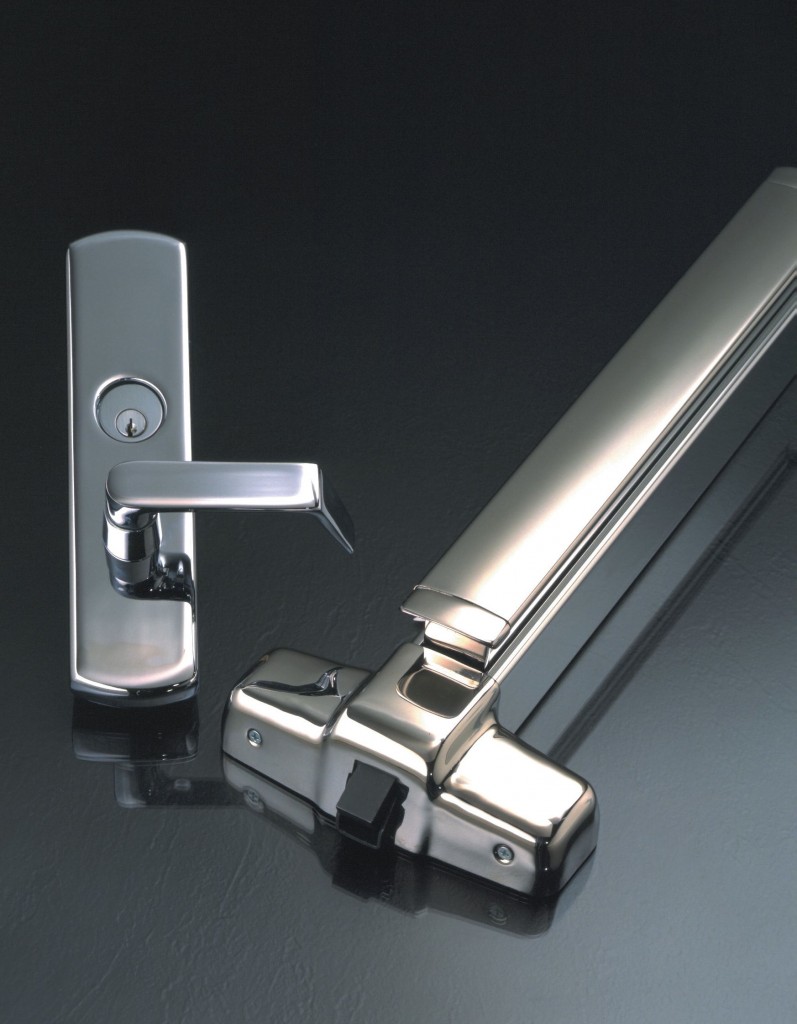Last week I got a compliment about this site from a security consultant, and I asked him if there were any topics he’d like me to do a post about. He said that a post on electrified lever trim (E) vs. electric latch retraction (EL) would be helpful since he spends a lot of time explaining the difference to his clients. So Michael, this is for you, and everyone out there who has been wondering how to choose between the two.
Both of these terms refer to electrified panic hardware functions. The products look essentially the same after they’re installed, but provide two distinctly different functions:
- How it Works: Electricity controls the locking/unlocking of the lever handle, so the lever can be used to retract the latch.
- Function: Can be fail safe (electricity locks the lever) or fail secure (electricity unlocks the lever). The panic hardware provides free egress from the push side at all times.
- Applications: Used for stairwell reentry, or for access control when the latch doesn’t need to be retracted electronically.
- Advantages: No special power supply required, low current draw. Can interface with fire alarm to provide “fail safe” door operation – door unlocked but still latched upon fire alarm. Very quiet electronic operation.
- Disadvantages: Can not be used for doors with automatic operators or where latch needs to be retracted electronically. Increased mechanical usage of the panic hardware because the latch can’t be held retracted (dogged) and the latch engages in strike each time the door is closed.
EL (Electric Latch Retraction)
- How it Works: Electricity retracts the latchbolt(s) of the panic hardware, so the door can be pushed or pulled open without retracting the latches manually.
- Function: Fail secure only – when power is cut, the latches project and secure the opening from the pull side. The panic hardware provides free egress from the push side at all times.
- Applications: Used for access control – especially high volume openings where doors will be left unlocked for extended periods, quiet operation of doors to sound-sensitive areas, dogging of fire doors such as cross-corridor pairs (fire alarm projects latch), and doors with automatic operators (latch must be released before door is opened by auto operator).
- Advantages: Latch is held retracted electronically, reducing the mechanical usage of the panic hardware and eliminating the sound of the latch engaging in the strike. With electric latch retraction panic hardware, door pulls can be used instead of lever handles where aesthetics are top priority. Provides “dogging” function for fire doors.
- Disadvantages: High current inrush for some models requires specific power supply located in the vicinity of the door, and larger gauge wires. Electric retraction of latch is audible on some models (although Von Duprin now offers the QEL – Q for “Quiet). Can not be used for stairwell reentry or locations where “fail safe” operation is required.
Feel free to chime in with anything I forgot to mention. If there are other topics or questions you’d like me to cover, please let me know!
You need to login or register to bookmark/favorite this content.







The terms Fail Safe/Fail Secure make perfect sense to me for MagLocks and E-Strikes, but often trip me up when dealing w/Exit Devices.
Personally I prefer the terms “Electric-Locking” and “Electric Unlocking” to describe the electrified trim on Exit Devices. The corresponding acronyms EL and EU just make more sense (to my novice mind) than the terms “Fail Safe” and “Fail Secure” when it comes to electrified levers. I believe the EL/EU convention is utilized by one or more MFRs relative to Electrified Mortise Locksets. And since Electrified Locksets are functionally similar to Exit Devices w/electrified trim – it just seems more natural, and easier to explain to my Architect colleagues who less experience w/electrified hardware.
Also in my specs, I use ELR to describe “Elect Latch Retraction” – so as not to be confused w/EL for “Electric Locking”. TC
Lori, I’d love to get your input on when you would recommend ELR over electric strikes. I know they will last longer, are more robust, and have a lot more options. The only disadvantage is that they cost more up front. What else would you tell an owner trying to make the decision on which to use?
Hi Justin –
For new openings I prefer ELR because of all the reasons you stated, plus there are advantages (both aesthetic and security/vandalism-related) to having the electronics “invisible.” I prefer ELR for existing doors too, but sometimes it’s cost-prohibitive to get the wires into the door. Sometimes getting the power supply close to the door for an ELR device can be a problem, but that is improving as device power requirements change.
– Lori
This article is the perfect answer for 2/3 of a question I am facing. The final 1/3 would include Electric Strikes. Do you think you could put together all of these elements you’ve listed for Electric Trim and Electrified Latch Retraction?
Thank you
Jim Dahlstrom
Hardware Project Manager
Wow – this post is so old that I have no recollection of writing it! Here you go:
Electric Strike
How it Works: The electric strike replaces the standard strike on the frame (or the inactive leaf of a pair). Electricity controls the strike keeper, which secures or releases the latchbolt of the lockset or panic hardware. When the keeper is released, the latchbolt can be pulled through to open the door.
Function: Fail secure or fail safe – sometimes field selectable. Fail secure – when power is cut, the strike keeper is secure and the latchbolt can’t be pulled through. Fail safe – when power is cut, the strike keeper is free and the latchbolt can be pulled through. The lockset or panic hardware typically allows free egress from the egress side at all times. Fail safe electric strikes can not be installed on fire door assemblies.
Applications: Used for access control where a simple solution is needed and especially for retrofit work where it is more complicated for wires to extend from the frame into the door. May be used to release the latch on doors with automatic operators.
Advantages: Usually easier to retrofit, which may mean lower installed cost.
Disadvantages: More visible and possibly easier to defeat than most other types of electrified hardware.
– Lori
That is really cool that electricity can control the locking and unlocking of a lever handle. That might be really helpful for someone who wants to keep their building secure. Getting something that can lock and unlock something electrically for exiting would be really nice to have.